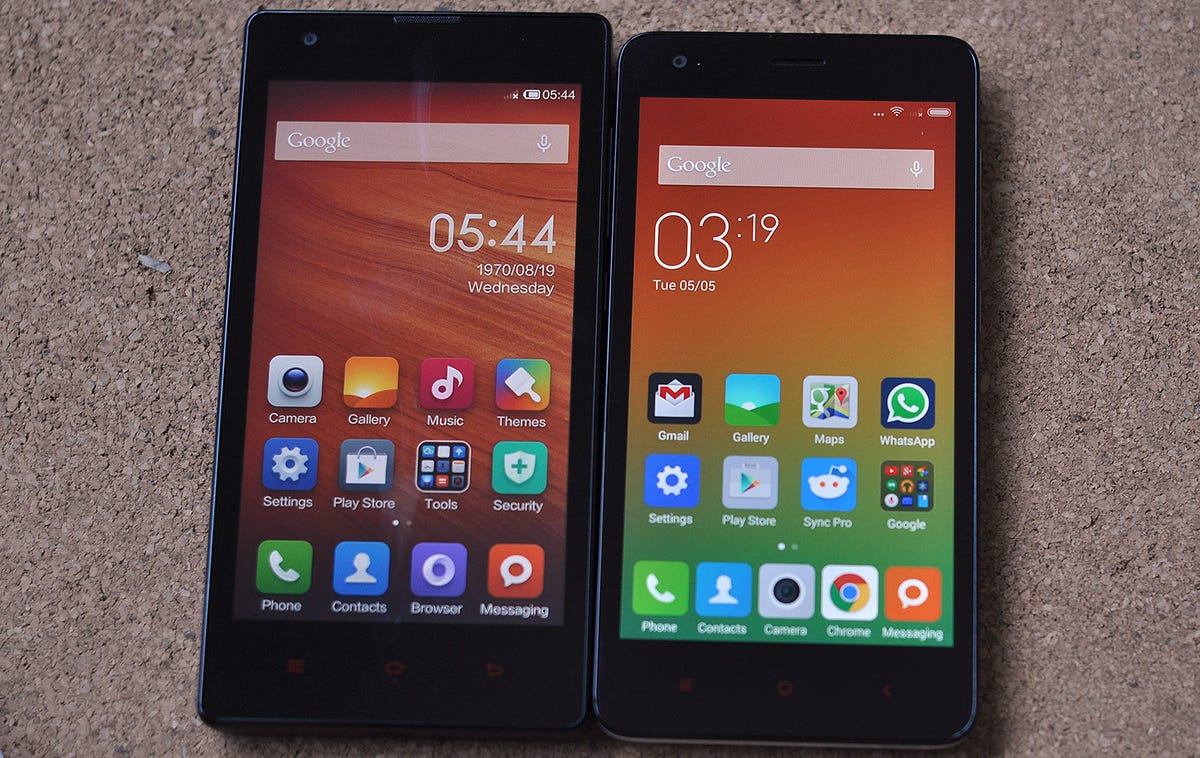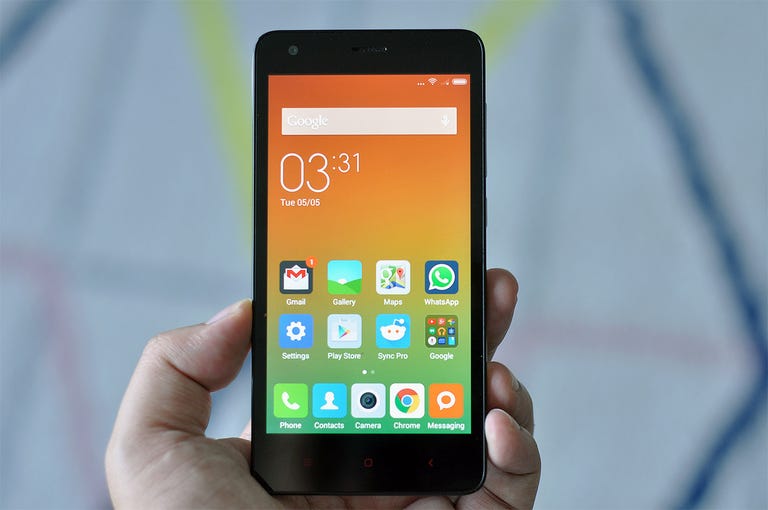 Why You Can Trust CNET
Why You Can Trust CNET Xiaomi Redmi 2 review: Value, but not without cost
Xiaomi's wallet-friendly Redmi 2 offers great value for its price, but only if you're willing to accept the many trade-offs.
Chinese smartphone maker Xiaomi is well-known for its low-cost, high-quality products, but unfortunately, the Redmi 2 fails to live up to expectations. That isn't to say the sub-$120 (roughly £75 or AU$140) smartphone is a bad device, but slight performance issues hamper what would otherwise be a great phone for its price.
The Good
The Bad
The Bottom Line
First and foremost, the Redmi 2 is a budget phone, so it's not using the fastest processor possible or packing a lot of RAM. This can lead to noticeable sluggishness when more resource-hogging apps such as Facebook Messenger start running in the background. But if you don't use that, the phone can run pretty smoothly.
Performance issues aside, the phone does come packed with features, including the latest version of the company's easy-to-use MIUI, dual-SIM 4G capabilities and an 8-megapixel rear camera that takes surprisingly decent shots in good lighting.
If you're looking for a cheap phone, this is probably a good buy, though if you live in the US, UK or Australia, you'll have to get it from online resellers at a slight premium. Unfortunately, Xiaomi doesn't sell its phones in stores in those countries -- it's still focused on Asian markets such as India, but those in South America, in particular Brazil, may soon get the chance to purchase one when the company moves forward with its expansion plans.
Design
- 4.7-inch, 1,280x720-pixel IPS display (312ppi)
- 5.3 by 2.7 by 0.4 inches (134 by 67.2 by 9.4 mm)
- 4.7 ounces (133 grams)
Like the original Redmi, the Redmi 2's design keeps it simple. What you get is a dull-looking rectangular phone with rounded corners and a plastic rear. It's not much to look at, but it seems Xiaomi has gone with a more basic design to keep costs down.
The Redmi 2 greatly resembles the original phone, down to the position of the rear camera, volume and power buttons (located on the right side). The key difference, however, is that the Redmi 2 is slightly smaller when placed side by side, as you can see in the picture below.

Under the rear cover, you'll find a removable 2,200mAh battery, a microSD card slot and two 4G SIM slots sized for micro-SIMs. The battery's slightly larger in capacity compared to the Redmi (2,000mAh), but a larger battery is necessary since the Redmi 2 runs on 4G LTE (instead of 3G only, like the Redmi).
The 3.5mm audio jack is located along the top edge, while the Micro-USB port if found on the bottom right edge of the phone. Interestingly, the phone's speakers are found next to the rear camera instead of lower down at the bottom like most other phones.
Weighing at 133 grams (4.7 ounces), the phone packs quite a heft in the hands, delivering a solid reassuring feel. The 4.7-inch IPS display is also bright and viewable under bright sunlight, and stays that way when viewed from pretty much any angle. The handset sports a 1,280x720-pixel display. Not an impressive spec, but not too shabby either for its price.
Hardware and software
- 1.2GHz quad-core Snapdragon 410
- 8GB of storage
- 1GB of RAM
- Expandable storage
- 2,200mAh nonremovable battery
Powered by a 64-bit Qualcomm Snapdragon 410 processor clocked at 1.2GHz, the Redmi 2 packs 1GB of RAM and 8GB of onboard memory. It also microSD card support for up to 32GB of extra storage.
As mentioned, the phone supports 4G, and in particular LTE bands 3, 7 and 8 on the FDD LTE standard. This means the phone will be able to use 4G in markets such as UK and Australia but not in the US.
Software-wise, the phone is powered by Android 4.4 but runs Xiaomi's own MIUI 6.0. The custom skin adds quite a bit of features to the phone, including my favorite feature, which lets you shift apps around by tapping and holding on an app and using another finger to flick to another screen. And while it's not running Lollipop, Xiaomi's MIUI includes plenty of useful thoughtful features last seen on the Mi 4i.
While the UI is similar to iOS, with apps located on the home screen, the drop-down notification menu is more closely related to Android and comes loaded with shortcuts that give you quick access to turning the Wi-Fi and Bluetooth on and off, and putting the phone in airplane mode, among other things. You can also quickly turn on the flashlight from the lock screen by holding down the button, a feature I'm told was added after suggestions from Xiaomi's customers.
Other features include the ability to select different themes, and an easy mode that changes the UI into something simpler with bigger dial pads and icons. That's perfect for users who aren't as familiar with modern smartphones.
One thing that Android users should take note of is that like most Chinese-designed UIs, the phone doesn't have an app drawer -- as mentioned, apps are all located on the home screen. It's a mixture of Android and iOS, so if you're familiar with either system, it shouldn't take you long to get used to the phone. Check out the screenshots below for a look at the UI.
Camera
- 8-megapixel rear camera
- 1080p HD video
- 2-megapixel front-facing camera
The Redmi 2 comes with an 8-megapixel rear camera and a front 2-megapixel shooter. Interestingly, unlike most budget handsets in the market, the Redmi 2's camera does offer decent performance, and has a speedy shutter to boot. Startup time is a little slow, but that's mostly due to the phone's processing power, which I'll talk a bit more in the following section.
The Redmi 2's camera also comes with HDR mode, a countdown mode for taking better selfies, panorama and a manual option if you like to tweak things. There aren't any overly complicated features to the camera app -- a good thing, in my opinion.
Besides normal shots, you can take full HD videos with the rear camera, and while the camera does an adequate job of capturing video, I noticed that the automatic exposure can be a tad aggressive, which can white out your video if you're moving from a light source too quickly. It shouldn't be an issue if you're shooting a video in bright light, though.
For the front 2-megapixel camera, the image quality isn't very great; shots will look muddy even though there's bright light. On the bright side, you'll have some fun with the built-in age and gender detection, which displays them onscreen. It's often accurate at times, but you'll get some laughs when it sometimes shows your friend being 20 years older than they actually are.
Check out the test shots below.
Performance
In my day-to-day use of the phone, I initially found the performance sluggish at times. I thought this was originally a problem with the Qualcomm Snapdragon 410 quad-core processor, but it seems like it's probably due to Facebook Messenger combined with the phone only having 1GB of RAM.
Messenger seems to be quite the resource hog (even on other high-end phones), and the replacement review unit of the Redmi 2 I tested out seemed to exhibit the same issues, so it could be Messenger. Although, having only 1GB of RAM will lead to a poor experience with multitasking -- that's what I usually find on phones with similar specs.
Anecdotally, the Redmi 2 took 37 seconds to boot, but there's a slight 1-second wait for the camera to start when completely closed. There was no noticeable delay for the shutter, though.
On the benchmarking front though, the Redmi 2 seems to hold its own. It scored an average of 11,290 in the Quadrant benchmark tests, which shows the handset is better than similar specced devices, including the ZTE Grand X Max+, though it loses out to the Moto E (powered by a Snapdragon 200 processor) which scored 13,528 in the same test.
Against the more expensive $180 Samsung Galaxy Grand Prime, the Redmi 2 seems able to match scores, which puts the lower-priced phone in a much better light. Lastly, I also ran the test in Performance mode of the phone but there wasn't any noticeable differences in score.
Performance test
| Test 1 | Test 2 | Test 3 | Average | |
| Geekbench 3 | 1437 | 1473 | 1476 | 1,462 |
| Quadrant | 11758 | 11833 | 12002 | 11,864 |
| 3DMark Ice Storm Unlimited | 4382 | 4411 | 4334 | 4,376 |
Geekbench 3
3DMark - Ice Storm Unlimited
Battery life
In our CNET Videos Lab test, the phone lasted 11 hours and 24 minutes. If you're wondering how much that translates to in real-life use, based on my personal experience with the phone during the week that I spent reviewing it, that's about a full day. Since the 2,200mAh battery is removable, you can carry a spare with you if you need to go longer. Alternatively, Xiaomi's own power banks are great for keeping you juiced up, too.
Call quality
I didn't encounter any issues with the phone's audio when making calls, and the speaker is decently loud enough that you won't have trouble hearing it. In a more quiet environment such as the office, though, it's better to keep the phone on silent as you'll more than likely tick people off when notifications start chiming in. For 4G data speeds, the phone was tested on the SingTel network in Singapore, where it managed to hit a high of 49.2 Mbps for download speeds in five tests.
Conclusion
If it weren't for the low 1GB of RAM, the Xiaomi Redmi 2 would definitely make a great phone. It's a drawback, but performance is something you have to give up when it comes to most devices in this price category.
The Samsung Galaxy Grand Prime offers similar performance, but the Redmi 2 delivers it for a much cheaper price. Of course, there are other budget phones, such as the $150 Moto E and the myriad other cheap handsets from China available from online retailers. The Redmi 2 seems to offer the best value as it is.
With its low price, the Redmi 2 is a good phone for those who need a cheap 4G dual-SIM device, especially travelers who need a second phone for an upcoming vacation or work trip.


